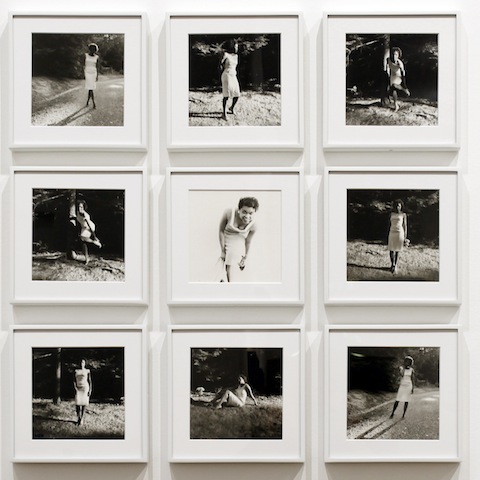Not so long ago, photographers were rejoicing in the freedom the digital revolution seemed to bring; unencumbered by the limitations of film, paper and darkroom practice, photography was suddenly liberated from the niggling pedantry of material constraints.
So it is in the cyclical nature of things that the photographers shortlisted for this year’s Deutsche Börse Prize all hark back, in some way, to pre-digital image-making, whether in their choice of equipment, technique or subject matter. Brett Rogers, director of the Photographers’ Gallery, argues that this illustrious prize plays a critical role in “reflecting the shifting boundaries of this mercurial medium”, and as such it is surely indicative of a renewed emphasis on the medium itself that all but one of the nominees reject the ubiquitous C-type print in favour of black and white.
 A decision to use a redundant film stock, developed by the US military in the 1940s, lies at the heart of Richard Mosse’s pictures of war in the Democratic Republic of Congo. (Pictured above: Safe From Harm, 2012.) The film detects infra-red light from foliage, picking out the greens of the jungle in vivid magentas and so revealing camouflaged soldiers whose khaki uniforms and natural skin tones jar with this psychedelic version of the world. In Mosse’s images of a “disorienting, kaleidoscopic conflict”, the natural becomes alien while the sight of soldiers armed to the teeth is cast as normality. Their impact is undeniable, but his methods feel like gimmickry. As a retort to the conventions of war photography Mosse’s pictures are unconvincing.
A decision to use a redundant film stock, developed by the US military in the 1940s, lies at the heart of Richard Mosse’s pictures of war in the Democratic Republic of Congo. (Pictured above: Safe From Harm, 2012.) The film detects infra-red light from foliage, picking out the greens of the jungle in vivid magentas and so revealing camouflaged soldiers whose khaki uniforms and natural skin tones jar with this psychedelic version of the world. In Mosse’s images of a “disorienting, kaleidoscopic conflict”, the natural becomes alien while the sight of soldiers armed to the teeth is cast as normality. Their impact is undeniable, but his methods feel like gimmickry. As a retort to the conventions of war photography Mosse’s pictures are unconvincing.
 In her series, Summer ‘57/ Summer ’09, 2009 (pictured above: installation detail), Lorna Simpson has carefully reconstructed a collection of 1950s photographs bought secondhand. The pictures seem to be all of one woman adopting classic pin-up poses, and Simpson’s reconstructions, in which she takes on the role of this anonymous woman, are surprisingly hard to pick out from amongst the originals. There is something quite unsettling about the ease with which she has taken over this woman’s persona, but it suggests that since the Fifties little has changed in the way that women’s bodies are presented and viewed.
In her series, Summer ‘57/ Summer ’09, 2009 (pictured above: installation detail), Lorna Simpson has carefully reconstructed a collection of 1950s photographs bought secondhand. The pictures seem to be all of one woman adopting classic pin-up poses, and Simpson’s reconstructions, in which she takes on the role of this anonymous woman, are surprisingly hard to pick out from amongst the originals. There is something quite unsettling about the ease with which she has taken over this woman’s persona, but it suggests that since the Fifties little has changed in the way that women’s bodies are presented and viewed.
 Like Simpson, Jochen Lempert invokes ideas about memory and record-keeping, and in so doing he exploits physical aspects of the medium to great effect. Lempert started out as a biologist, and his pictures, which often take the natural world as their subject, have the quality of working records. Unmounted and taped to the wall, Lempert has made a virtue of the way that prints on traditional, now virtually redundant, photographic papers curl at the edges, and the effect steeps his work in nostalgia. Lempert’s gaze is drawn to patterns, and many of his pictures show constellations, whether of stars, flying geese, swarms of insects or freckles on a shoulder. Moving between images of flowers, sand and raindrops, scale loses meaning, but the resulting abstraction serves to emphasise the patterns and similarities between things, so that the four white blobs and black squiggles of shadow in Untitled (four swans), 2006, look just like tadpoles (pictured above).
Like Simpson, Jochen Lempert invokes ideas about memory and record-keeping, and in so doing he exploits physical aspects of the medium to great effect. Lempert started out as a biologist, and his pictures, which often take the natural world as their subject, have the quality of working records. Unmounted and taped to the wall, Lempert has made a virtue of the way that prints on traditional, now virtually redundant, photographic papers curl at the edges, and the effect steeps his work in nostalgia. Lempert’s gaze is drawn to patterns, and many of his pictures show constellations, whether of stars, flying geese, swarms of insects or freckles on a shoulder. Moving between images of flowers, sand and raindrops, scale loses meaning, but the resulting abstraction serves to emphasise the patterns and similarities between things, so that the four white blobs and black squiggles of shadow in Untitled (four swans), 2006, look just like tadpoles (pictured above).
His interest in scale may have lead Lempert to experiment with photograms, the cameraless photographs made famous by Man Ray, in which objects are placed directly onto photosensitive paper and exposed to light. The technique means, of course, that solid objects are rendered in silhouette, and in his photogram, Four Frogs, 2010, the frogs appear bright white against black, creating a curiously artificial, schematic result.
 Beguiling as Lempert’s work is, it is the dangerous vitality of Alberto García-Alix’s pictures that steals the show. Documenting his own precarious life in the difficult years following the death of General Franco, the Spanish photographer has been nominated for his book Autorretrato/Selfportrait, 2013. The title seems a straightforward enough indication of subject matter, and yet the photographer himself is curiously elusive; García-Alix is often photographed from behind, and when, as in My feminine side, 2002 (pictured above), his gaze is directed squarely at the camera, the tongue-in-cheek title pulls the rug out from under our feet once again. A devotee of the Hasselblad camera with its trademark square format, García-Alix’s work is redolent of classic black and white photography, an image like My kitchen, 1982, bearing the compositional structure and control of a still-life.
Beguiling as Lempert’s work is, it is the dangerous vitality of Alberto García-Alix’s pictures that steals the show. Documenting his own precarious life in the difficult years following the death of General Franco, the Spanish photographer has been nominated for his book Autorretrato/Selfportrait, 2013. The title seems a straightforward enough indication of subject matter, and yet the photographer himself is curiously elusive; García-Alix is often photographed from behind, and when, as in My feminine side, 2002 (pictured above), his gaze is directed squarely at the camera, the tongue-in-cheek title pulls the rug out from under our feet once again. A devotee of the Hasselblad camera with its trademark square format, García-Alix’s work is redolent of classic black and white photography, an image like My kitchen, 1982, bearing the compositional structure and control of a still-life.
For pictures that linger over the sordid details of drug-addled excess, García-Alix’s work is strangely restrained, his sardonic juxtapositions of image and title punctuating often grim and disturbing images with verve and energy. His self-portraits direct our attention to a bigger narrative about the experiences of a whole generation shaking off the past and adjusting to new-found freedom and García-Alix shows the capacity of photography to combine poetry and documentary, to make compelling, insightful even, beautiful pictures that plumb the depths of human existence while retaining both honesty and dignity. For this reason he should win.









![SEX MONEY RACE RELIGION [2016] by Gilbert and George. Installation shot of Gilbert & George 21ST CENTURY PICTURES Hayward Gallery](/sites/default/files/styles/thumbnail_125_x_125_/public/mastimages/Gilbert%20%26%20George_%2021ST%20CENTURY%20PICTURES.%20SEX%20MONEY%20RACE%20RELIGION%20%5B2016%5D.%20Photo_%20Mark%20Blower.%20Courtesy%20of%20the%20Gilbert%20%26%20George%20and%20the%20Hayward%20Gallery._0.jpg?itok=3oW-Y84i)





Add comment